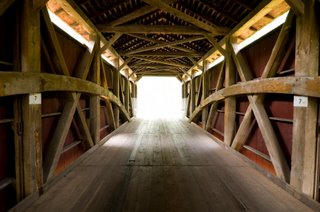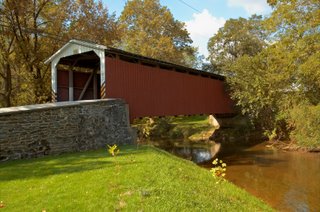|
An Introduction to Lancaster County Covered Bridges
Covered bridges are one of the most visible popular reminders of Lancaster County's past. At one time, bridges were routinely covered because they protected the roadbed from the rain, snow, wind, and sun. This protective covering increased the longevity and safety of the bridge. Without such a protective covering,a wooden roadbed would usually wear out and become dangerous after 15 to 20 years. The cover tended to increase the lifespan to about a century. The first covered bridge spanned the Schuylkill River in Philadelphia. The longest covered bridge stretched 5,960 feet and spanned the Susquehanna River in Columbia. This bridge was eventually burned down to prevent the advancing enemy soldiers during the Civil War. Today, Pennsylvania has more covered bridges than any other state. Furthermore, Lancaster County has more of these bridges than any other Pennsylvania County. Of the 226 surviving bridges in the state, 30 of them can be found in Lancaster County. The oldest surviving Lancaster County covered bridges dates back to 1843 while the most recent one was constructed in 1962. The lengths of the bridges vary greatly. The shortest bridge is 53 feet in length while the longest surviving covered bridge in Lancaster County is 200 feet long. Presently, 22 of these 30 Pennsylvania Dutch bridges are still fully operational. The other eight are either either privately owned or open for pedestrian traffic only. Lancaster County works hard to make sure that these remaining bridges are preserved against man-made accidents or natural events such as when Hurricane Agnes destroyed a large number of the surviving bridges in 1972.
Things to Know about Covered Bridges
Covered Bridges tend to be very narrow. The reason is that trucks did not exist at the time the bridges were constructed. The common requirement was that bridges merely had to be high and wide enough to permit a wagon or a buggy. Also, traffic was never very busy so there was no reason to create anything other than a single-lane bridge. Before you enter, be sure that another vehicle is not coming from the opposite direction. Another thing to consider is that the bridges were never designed to support a great deal of weight. The weight limit tends to be about 5 tons. The height limit is about 11 -11 1/2 feet. So, keep that in mind if you are driving a RV. Finally, drive slowly. Otherwise, it will be bumpy ride.
|

